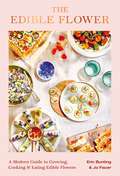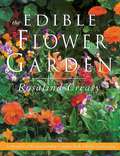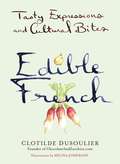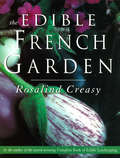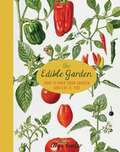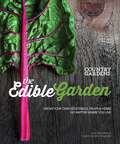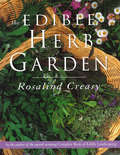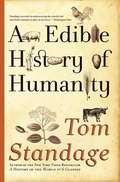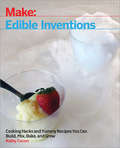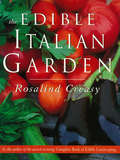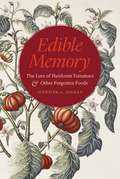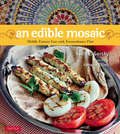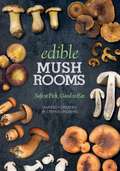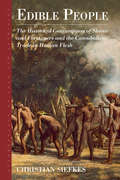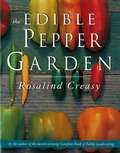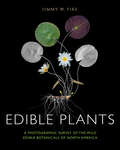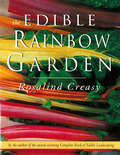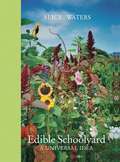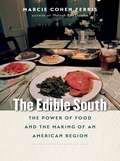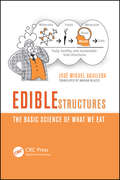- Table View
- List View
The Edible Flower: A Modern Guide to Growing, Cooking and Eating Edible Flowers
by Erin Bunting Jo FacerOn a seven-acre small holding in rural Northern Ireland, organic gardener Jo Facer and head chef Erin Bunting run fork-to-fork supper club, organic small-holding and fledgling cooking and growing school, The Edible Flower. In their first cookbook, learn to grow and cook edible flowers with Jo and Erin's delicious recipes inspired by the seasonal produce they grow in their kitchen garden and the wild food they forage from their local shores and hedgerows. Feast, celebrate and bring people together with over 50 recipes for small plates, mains, desserts, baking, snacks and drinks, at once fresh and flavourful and absolutely stunning to serve. Recipes include: Ribboned Courgette & Avocado Salad with Poppy Seeds & Calendula, Pot Marigold Soda Bread,Lilac Panna Cotta with Strawberries,Rice with Lemon Verbena, Cardamom & Edible Flower Petals,Marigold Petal Pasta,Courgette Flower Tacos,Carnation and Blackberry Cooler,Slow Roast Lamb with Lavender, Lemon & Apricots, Blackberry & Sweet Geranium Tart,Vietnamese Summer Rolls with Violas,Aubergine Katsu Curry with Pickled Magnoliaand many more ...
The Edible Flower Garden
by Rosalind CreasyA comprehensive guide to selecting and growing flowers that can be used for cookery, both as garnishes and as ingredients.
Edible Food Packaging: Applications, Innovations and Sustainability
by Amrita Poonia Tejpal DhewaThis book discusses the various aspects of sustainable packaging edibles in food industry. It is divided into five main parts. The first section of the book addresses details of edible films, various sources, origin, scope and functions. Second section covers different sustainable alternatives such as seed gums, fruits and vegetable peels, sea weeds, fruits wastes, dairy by products & anti-oxidant edible packaging. This book also discusses about methods of improvements of mechanical properties of packaging edibles & their food applications, testing methods, innovations, limitations, challenges and nano edibles. It provides insights about the large quantity of wastes and by-products generated by food processing industries. Disposal of these wastes is a big problem due to their high biochemical oxygen demand (BOD) & chemical oxygen demand (COD) which causes severe problem of pollution to the environment. These wastes contain large amounts of proteins, carbohydrates, lipids, minerals, various bioactive compounds and have eco-friendly packaging potential. The book emphasizes on the fact that recycling these wastes as packaging edibles are sustainable and economical. As a world foreseeing food technology revolution, this book explores the unique topics in food packaging which possesses mammoth commercial applications and environmental potential. Due to its immense scope, this book is highly useful for researchers, food scientists, students and food packaging industry experts.
Edible French
by Clotilde Dusoulier Melina JosserandThe idiosyncrasies of language can tell us a lot about a culture. In this delightful book, Clotilde Dusoulier, creator of the award-winning food blog Chocolate & Zucchini, delves into the history and meaning of fifty of the French language's most popular food-related expressions. Accompanied by beautiful watercolor illustrations by artist Mélina Josserand, Edible French explores whimsical turns of phrase such as: Tomber dans les pommes (falling into the apples) = fainting Se faire rouler dans la farine (being rolled in flour) = being fooled Avoir un cœur d'artichaut (having the heart of an artichoke) = falling in love easily A treat of a read for Francophiles and food lovers alike, Edible French is the tastiest way to explore French culture--one that will leave you in high spirits--or, as the French say, vous donnera la pêche (give you the peach).
The Edible French Garden
by Rosalind CreasyHighlights the vegetables of French cuisine such as endive, shallots, and celery. Advice on growing and cooking with classic French vegetables.
The Edible Garden
by Alys FowlerIn this timely new book, BBC star and Gardening World's thrifty and resourceful Alys Fowler shows that there is a way to take the good life and re-fashion it to fit in with life in the city. Abandoning the limitations of traditional gardening methods, she has created a beautifully productive garden where tomatoes sit happily next to roses, carrots are woven between the lavenders and potatoes grow in pots on the patio. And all of this is produced in a way that mimics natural systems, producing delicious homegrown food for her table. And she shares her favorite recipes for the hearty dishes, pickles and jams she makes to use up her bountiful harvest, proving that no-one need go hungry on her grow-your-own regime.Good for the pocket, good for the environment and hugely rewarding for the soul, The Edible Garden urges urbanites everywhere to chuck out the old gardening rules and create their own haven that's as good to look at as it is to eat.
The Edible Garden: Grow Your Own Vegetables, Fruits & Herbs No Matter Where You Live
by The Editors of Country Gardens MagazineA seasonal guide to crops with descriptions of varieties for each, including when and how to plant. All the basics you need to start, from tools and containers to seeds and soil. Simple recipes that show how to use your crop yield—and what to do when your garden produces more than you ever expected! Covers a wide range of topics, including: Starting from Seed: Save money by growing from seeds—including those you save yourself from your everyday meals. Making the Plan: How to assess the space at hand and plan to use it most efficiently, including seasonal tips for various environments. Organic Solutions: Raise the healthiest food and protect the environment with these handy hints, including all-natural, chemical-free pest repellants, weed control, and soil enrichment. Container Gardening: Grow food for your table on a balcony, patio, or other small space. Special tips on how to grow some basics even if you&’ve only got a window box to work with. Raised-Bed Gardens: All the rage in suburban front and back yards, rooftops, and community gardens, this results-intensive gardening method yields amazing harvests. Yard-to-Table: Recipes for your backyard bounty focusing on just-picked delights such as fresh tomato and arugula salad, crispy zucchini fritter, and cool cucumber sangria.
The Edible Herb Garden
by Rosalind CreasyNow from the doyenne of edible landscaping comes a comprehensive and accessible guide to cultivating and cooking herbs.If you have only one book on growing, harvesting and cooking with herbs, this should be it. Creasy takes you from seeds to stove top, from preparing soil to elegant dining, with easy-to-follow instructions and inspirational, imaginative ideas for every step of the way, with a complete "Resources" section.There's information on how to design and grow an herb garden just about anywhere - from a spacious country plot to a small city balcony, from California to Maine and anywhere in between.
The Edible Herb Garden
by Rosalind CreasyLearn how to grow hardy and fragrant herbs then use them create delicious meals with this beautifully illustrated herb gardening and cooking book. Author Rosalind Creasy takes you from seeds to stove top, from preparing soil to elegant dining, with easy-to-follow instructions and inspirational, imaginative ideas for every step of the way, with a complete "Resources" section. There's information on how to design and grow an herb garden just about anywhere--from a spacious country plot to a small city balcony, from California to Maine and anywhere in between. With vivid photographs you'll tour various gardens Creasy has created, plus the garden of herb luminary Carole Saville, among others.The comprehensive, fully illustrated "Encyclopedia of Culinary Herbs" section illustrates how to grow and use more than two dozen herb varieties. It includes both old favorites--basil, rosemary, sage, and the like--as well as more exotic herbs from around the world, including salad burnet, lemon verbena, and Mexican tarragon.In the "Favorite Herb Recipes" section you'll find delicious recipes as well as instructions for accompaniments--herb blends and butters, vinegars and teas; main dishes from cuisines around the world; and even cocktails and desserts
Edible Histories, Cultural Politics
by Marlene Epp Franca Iacovetta Valerie J. KorinekJust as the Canada's rich past resists any singular narrative, there is no such thing as a singular Canadian food tradition. This new book explores Canada's diverse food cultures and the varied relationships that Canadians have had historically with food practices in the context of community, region, nation and beyond.Based on findings from menus, cookbooks, government documents, advertisements, media sources, oral histories, memoirs, and archival collections, Edible Histories offers a veritable feast of original research on Canada's food history and its relationship to culture and politics. This exciting collection explores a wide variety of topics, including urban restaurant culture, ethnic cuisines, and the controversial history of margarine in Canada. It also covers a broad time-span, from early contact between European settlers and First Nations through the end of the twentieth century.Edible Histories intertwines information of Canada's 'foodways' - the practices and traditions associated with food and food preparation - and stories of immigration, politics, gender, economics, science, medicine and religion. Sophisticated, culturally sensitive, and accessible, Edible Histories will appeal to students, historians, and foodies alike.
An Edible History of Humanity
by Tom StandageIn this book, Tom Standage charts the enlightening history of humanity through the foods we eat. More than simply sustenance, food historically has been a kind of technology, changing the course of human progress by helping to build empires, promote industrialization, and decide the outcomes of wars. Tom Standage draws on archaeology, anthropology, and economics to reveal how food has helped shape and transform societies around the world, from the emergence of farming in China by 7500 b.c. to the use of sugar cane and corn to make ethanol today.
Edible Inventions: Cooking Hacks and Yummy Recipes You Can Build, Mix, Bake, and Grow
by Kathy CeceriBelieve it or not, there's a lot of inventing going on in the kitchen. Unless you only eat fruits and veggies right off the plant, you are using tools and techniques invented by humans to make food more tasty and easier to digest. When you cook food, you start to break it down into a form your body can absorb. When you add chemicals to make it thicker, gooey-er, or puffy-er, you turn a bunch of boring ingredients into a mouth-watering snack. Edible Inventions: Cooking Hacks and Yummy Recipes You Can Build, Mix, Bake, and Grow will show you some unusual ways to create a meal, and help you invent some of your own. Projects include:3D printing with foodChemical cuisine and molecular gastronomyPrepared foods like jellies and pickles at homeGrowing your own ingredientsCooking off the grid
Edible Italian Garden
by Rosalind CreasyCreasy offers recommendations for selecting and growing the best varieties ofItalian herbs and vegetables: basil, broccoli rabe, fava beans, and tomatoes. Over 90 color illustrations.
Edible Memory: The Lure of Heirloom Tomatoes and Other Forgotten Foods
by Jennifer A. JordanEach week during the growing season, farmers markets offer up such delicious treasures as brandywine tomatoes, cosmic purple carrots, pink pearl apples, and chioggia beets varieties of fruits and vegetables that are prized by home chefs and carefully stewarded by farmers from year to year. These are the heirlooms and the antiques of the food world, endowed with their own rich histories. While cooking techniques and flavor fads have changed from generation to generation, a Ribston Pippin apple today can taste just as flavorful as it did in the eighteenth century. But how does an apple become an antique and a tomato an heirloom? In "Edible Memory," Jennifer A. Jordan examines the ways that people around the world have sought to identify and preserve old-fashioned varieties of produce. In doing so, Jordan shows that these fruits and vegetables offer a powerful emotional and physical connection to a shared genetic, cultural, and culinary past. Jordan begins with the heirloom tomato, inquiring into its botanical origins in South America and its culinary beginnings in Aztec cooking to show how the homely and homegrown tomato has since grown to be an object of wealth and taste, as well as a popular symbol of the farm-to-table and heritage foods movements. She shows how a shift in the 1940s away from open pollination resulted in a narrow range of hybrid tomato crops. But memory and the pursuit of flavor led to intense seed-saving efforts increasing in the 1970s, as local produce and seeds began to be recognized as living windows to the past. In the chapters that follow, Jordan combines lush description and thorough research as she investigates the long history of antique apples; changing tastes in turnips and related foods like kale and parsnips; the movement of vegetables and fruits around the globe in the wake of Columbus; and the poignant, perishable world of stone fruits and tropical fruit, in order to reveal the connections the edible memories these heirlooms offer for farmers, gardeners, chefs, diners, and home cooks. This deep culinary connection to the past influences not only the foods we grow and consume, but the ways we shape and imagine our farms, gardens, and local landscapes. From the farmers market to the seed bank to the neighborhood bistro, these foods offer essential keys not only to our past but also to the future of agriculture, the environment, and taste. By cultivating these edible memories, Jordan reveals, we can stay connected to a delicious heritage of historic flavors, and to the pleasures and possibilities for generations of feasts to come. "
An Edible Mosaic
by Faith GorskyWhen Faith Gorsky married her Middle Eastern husband, she married more than just the man. She found herself introduced to a culture and cuisine that would forever change how she experienced food and cooking.Faith's mother-in-law took her under her wing and in 6 months gave her a thorough course in Middle Eastern cooking that became the basis for her popular website, An Edible Mosaic. The growth and success of her website and her own developing interest led to more trips to the Middle East, deepening her knowledge of the cuisine which she shares in An Edible Mosaic.In her new cookbook, Faith imparts her favorite Middle Eastern recipes, recipes anyone can make with a little work and some help from Faith! Her love for the cuisine of her husband's homeland shows in her enthusiasm for these dishes and the awareness that food is more than just a means of sustenance for the people of the Middle East-it lies at the epicenter of their gatherings with family and friends.Recipes include:Parsley Salad with Bulgur Wheat (Tabbouleh)Creamy Chickpea and Yogurt Casserole (Fetteh)Mashed Fava Beans with Olive Oil, Lemon Juice, and Garlic (Foul Mudammas)Ground Chicken Kebabs (Kebab Dajaj)Sumac-Spiced Chicken (M'sakhkhan)Upside-Down Rice Casserole (Maqluba)Date-Filled Cookies (Ma'amoul)
Edible Mushrooms: Safe to Pick, Good to Eat
by Stefan Lindberg Barbro ForsbergWandering the woods in search of mushrooms is one of life's great pleasures. But be careful to pick the right ones! With Edible Mushrooms in your backpack, you'll know to pick only the safest, most delicious chanterelles, truffles, morels, and more. Author Barbro Forsberg presents forty edible species, and reveals how, when, and where to find them-knowledge gained over the course of four decades spent mushrooming in the woods.Discover such aspects of mushrooming as: Characteristics of edible mushrooms, per species Cooking, cleaning, and drying the day's bounty Edible, inedible, or toxic? Photographs and descriptions for what to pick and what to avoid Poisonous varieties and how to recognize themAll content has been verified by a professional mycologist. Plus, nature and educational photographs illustrate how mushrooms grow, the environments where you can expect to find them, and the ways in which the same species may vary from one sample to the next. So whether you're an experienced mushroom hunter or a novice to the art, with Edible Mushrooms you can confidently recognize, pick, and eat the tastiest wild mushrooms.
Edible People: The Historical Consumption of Slaves and Foreigners and the Cannibalistic Trade in Human Flesh (Anthropology of Food & Nutrition #11)
by Christian SiefkesWhile human cannibalism has attracted considerable notice and controversy, certain aspects of the practice have received scant attention. These include the connection between cannibalism and xenophobia: the capture and consumption of unwanted strangers. Likewise ignored is the connection to slavery: the fact that in some societies slaves and persons captured in slave raids could be, and were, killed and eaten. This book explores these largely forgotten practices and ignored connections while making explicit the links between cannibal acts, imperialist influences and the role of capitalist trading practices. These are highly important for the history of the slave trade and for understanding the colonialist history of Africa.
The Edible Pepper Garden
by Rosalind CreasyWith gorgeous, four-color photographs, and simple yet authoritative text, award-winning author Rosalind Creasy offers four new volumes in her popular Edible Garden series, each featuring helpful hints, expert gardening techniques, delicious recipes, and interviews with master gardeners and renowned chefs. From sweet peppers to four-alarm spicy ones, here are all the essentials on growing your own private pepper garden, including basic gardening tips and mouth-watering recipes for both the hot pepper lover and the faint of heart.
The Edible Pepper Garden
by Rosalind CreasyThe Edible Pepper Garden acquaints the pepper novice with the numerous members of the Capsicum annum species-from the pea-sized, blazing-hot chiltepin to the eight-inch sweet banana pepper-and gives the chile initiate inspiration and suggestions to expand their pepper repertoire. With stunning photography and extensive definitions and explanations, Rosalind Creasy, the doyenne of edible landscaping, has taken the American fascination with peppers and made it accessible to the home gardener and home chef alike. Creasy takes us on a tour of two of her own extremely successful pepper gardens-the first yielded twenty-one varieties of hot and sweet peppers! She provides variety-specific growing information along with culinary and preparation suggestions.
Edible Plants: A Photographic Survey of the Wild Edible Botanicals of North America
by Jimmy FikeFor over a decade, artist Jimmy Fike traveled across the continental United States in an epic effort to photograph wild edible flora. Edible Plants is the culmination of that journey, featuring over 100 photographs that Fike has selectively colorized to highlight the comestible part of the plant. While the images initially appear to be scientific illustrations or photograms from the dawn of photography when plants were placed directly on sensitized paper and exposed under the sun, a closer look reveals, according to Liesl Bradner of the Los Angeles Times, "haunting [and] eerily beautiful" photographs. Beyond instilling wonder, Fike's contemporary, place-based approach to landscape photography emphasizes our relationship to the natural world, reveals food sources, and encourages environmental stewardship. His clever and beautiful method makes it easy to identify both the specimen and its edible parts and includes detailed descriptions about the plant's wider purposes as food and medicine.Sumptuously illustrated and delightfully informative, Edible Plants is the perfect gift for anyone curious about unlocking the secrets of native North American plants.
Edible Rainbow Garden
by Rosalind CreasyWith gorgeous, four-color photographs, and simple yet authoritative text, award-winning author Rosalind Creasy offers four new volumes in her popular Edible Garden series, each featuring helpful hints, expert gardening techniques, delicious recipes, and interviews with master gardeners and renowned chefs. Purple potatoes and cream-colored tomatoes are just two of the delightful things to grow in a rainbow-colored garden. Here, Ros tells readers how to bring all the colors of the rainbow into their garden and onto their plate -- for a most delicious and colorful eating experience.
The Edible Salad Garden
by Rosalind CreasyCreasy shows readers how to grow favorite salad greens and vegetables then prepare them using delicious and unique recipes. Over 90 color illustrations.
Edible Schoolyard: A Universal Idea
by Alice Waters David Liittschwager Daniel DuaneOne of America's most influential chefs, Alice Waters created a revolution in 1971 when she introduced local, organic fare at her Berkeley, California, restaurant, Chez Panisse. Twenty-five years later, she and a small group of teachers and volunteers turned over long-abandoned soil at an urban middle school in Berkeley and planted the Edible Schoolyard. The schoolyard has since grown into a universal idea of Edible Education that integrates academics with growing, cooking, and sharing wholesome, delicious food. With inspiring images of the garden and kitchen and their young caretakers. Edible Schoolyard is at once a visionary model for sustainable farming and childhood nutrition, and a call to action for schools across the country.
The Edible South
by Marcie Cohen FerrisIn The Edible South, Marcie Cohen Ferris presents food as a new way to chronicle the American South's larger history. Ferris tells a richly illustrated story of southern food and the struggles of whites, blacks, Native Americans, and other people of the region to control the nourishment of their bodies and minds, livelihoods, lands, and citizenship. The experience of food serves as an evocative lens onto colonial settlements and antebellum plantations, New South cities and Civil Rights-era lunch counters, chronic hunger and agricultural reform, counterculture communes and iconic restaurants as Ferris reveals how food--as cuisine and as commodity--has expressed and shaped southern identity to the present day.The region in which European settlers were greeted with unimaginable natural abundance was simultaneously the place where enslaved Africans vigilantly preserved cultural memory in cuisine and Native Americans held tight to kinship and food traditions despite mass expulsions. Southern food, Ferris argues, is intimately connected to the politics of power. The contradiction between the realities of fulsomeness and deprivation, privilege and poverty, in southern history resonates in the region's food traditions, both beloved and maligned.
Edible Structures: The Basic Science of What We Eat
by Jose Miguel AguileraNature converts molecules into edible structures, most of which are then transformed into products in factories and kitchens. Tasty food structures enter our mouths and different sensations invade our bodies. By the time these structures reach our cells, they have been broken back down into molecules that serve as fuel and raw materials for our bod
